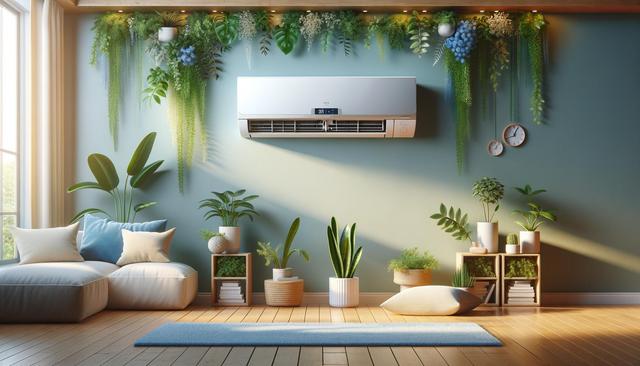What Is a Ductless Air Conditioner?
A ductless air conditioner, also known as a mini-split system, is a type of cooling solution that doesn’t require traditional ductwork to operate. Instead, it consists of two main components: an indoor air-handling unit and an outdoor compressor. These units are connected by a small conduit that houses the refrigerant tubing, power cable, and drain line. This design offers an efficient and space-saving alternative to conventional central air systems, making it a popular choice for homeowners seeking flexible cooling without a major renovation.
Unlike central air systems that push cooled air through a network of ducts, ductless AC units deliver air directly into individual rooms. This allows for zoned cooling, where you can control the temperature of specific spaces independently. Ductless systems are especially useful in homes without existing ductwork, older buildings, additions, or rooms that need extra cooling power. With their sleek design and quiet operation, they blend seamlessly into modern interiors.
Energy Efficiency and Cost Savings
One of the most compelling reasons to consider a ductless air conditioner is its potential for energy efficiency. Traditional HVAC systems can lose a significant amount of energy—up to 30%—through ductwork. Since ductless systems bypass this component altogether, they reduce these losses and operate more efficiently. This can lead to noticeable savings on your energy bills over time.
Ductless AC units use inverter-driven compressors that adjust their speed based on the cooling needs of the space, rather than turning on and off like conventional systems. This results in more consistent comfort and less energy use. Additionally, many models meet ENERGY STAR® guidelines, making them a smart choice for environmentally conscious homeowners. Key benefits include:
- Reduced energy loss due to the absence of ducts
- Lower monthly cooling costs
- Smaller carbon footprint
- Potential rebates and incentives from energy programs
Easy and Flexible Installation
Installing a ductless air conditioner is generally quicker and less invasive than installing a traditional central air system. Since it doesn’t require ductwork, there’s no need to tear into walls or ceilings. Most ductless systems can be installed in a day or two, depending on the complexity and number of indoor units needed. This makes them ideal for renovations or retrofitting older homes.
Flexibility is another advantage. The indoor units can be mounted on walls, suspended from ceilings, or even recessed, offering various design options to suit your space. The small outdoor unit can be placed up to 50 feet away from the indoor unit, allowing for discreet placement. This adaptability makes ductless systems an appealing choice for:
- Home additions or converted spaces like garages and basements
- Homes without existing ductwork
- Multi-family homes or apartments
- Targeted cooling in specific rooms
Improved Indoor Air Quality
Maintaining good indoor air quality is essential for health and comfort, and ductless air conditioners can contribute positively in this area. Unlike traditional systems that may circulate dust, allergens, or mold through ducts, ductless systems have multi-stage filtration built into each indoor unit. These filters are effective at capturing airborne particles and can help reduce allergens and pollutants inside your home.
Because each unit operates independently, you can clean or replace the filters more easily than with central systems. Regular maintenance ensures that the indoor environment remains healthy and that the system maintains optimal performance. Benefits related to air quality include:
- Reduced circulation of dust, pollen, and allergens
- Cleaner air with advanced filtration technology
- Humidity control for added comfort
- Lower risk of mold and mildew buildup
Custom Comfort and Smart Home Integration
Ductless air conditioners offer personalized comfort through zone control, allowing users to set different temperatures in different rooms. This not only improves comfort but also enhances energy efficiency by cooling only the spaces in use. For families with varying temperature preferences, this feature can be especially valuable.
Many ductless systems are compatible with smart thermostats or come with built-in Wi-Fi connectivity, enabling you to control them remotely via smartphone apps. This allows for better monitoring and management of your home’s cooling system, even when you’re away. Additional features may include:
- Programmable timers and schedules
- Remote access and control via app
- Integration with smart home ecosystems
- Real-time energy usage tracking
These modern features make ductless systems a forward-thinking solution for those looking to upgrade their home’s cooling with both efficiency and convenience in mind.
Conclusion: A Smart, Efficient Choice for Modern Homes
Choosing a ductless air conditioner is a practical decision for homeowners seeking efficient, customizable, and cost-effective cooling. Whether you’re renovating, adding on to your home, or simply looking for a more energy-conscious solution, a ductless AC system delivers flexible comfort without the need for major construction. With benefits like lower energy bills, easy installation, and improved air quality, it’s easy to see why more people are making the switch to ductless systems. Consider this modern cooling option to stay comfortable while maximizing both efficiency and savings.






